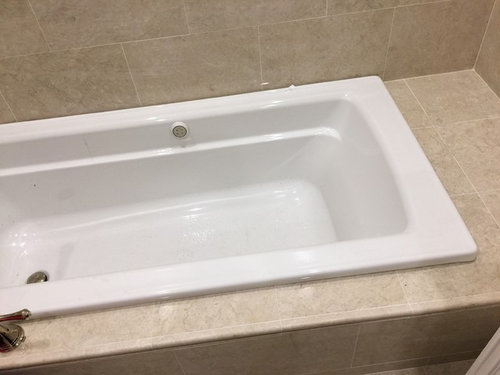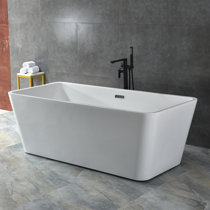Beginner's Plumbing: What You Need for Installing a Bathtub
Beginner's Plumbing: What You Need for Installing a Bathtub
Blog Article
What are your ideas concerning A Step-by-Step Guide to Installing a Bathtub?

Installing a bathtub isn't precisely brain surgery, yet it does call for solid plumbing, carpentry, and also occasionally, tiling skills. Replacing an old bathtub with a new one is additionally a reasonably hard task. If the old bathtub is conveniently accessible, the project can move rapidly; if you have to open a wall surface to get rid of the old bathtub and place the new bathtub, the task is much harder. In either instance, the task is within a house handyman's skills, although you will require an assistant to leave the old tub and also embeded in the brand-new one. See to it you have actually certified yourself for the work as well as are comfortable trying it. Instead of hiring a contractor to take control of a halfway-completed task, it is far better to think about employing one prior to you begin. Chances are you may need an expert plumber to make tube connections.
This short article will certainly help you set up a brand-new bath tub in your restroom if you have actually currently acquired a new tub and don't need to alter the plan of your previous water pipelines.
Your devices as well as product list need to consist of the following:
Removing Old Touches
If you need to replace old taps with brand-new ones as a part of your setup, after that the first thing you must do is detach the water supply. After doing so, activate the faucets to drain pipes any kind of water continuing to be in the system. The procedure of eliminating the existing taps can be quite problematic as a result of the limited gain access to that is typically the case.
Use a basin wrench (crowsfoot spanner) or a faucet tool to undo the nut that attaches the supply pipelines to the taps. Have a cloth all set for the continuing to be water that will originate from the pipes. Once the supply pipelines have been gotten rid of, utilize the very same tool to loosen the nut that holds the faucets onto the bath/basin. You will require to quit the single faucets from turning throughout this process. When the taps have been removed, the holes in the bath/basin will have to be cleansed of any old sealing compound.
Before going on to fit the new faucets, compare the pipe connections on the old faucets to the brand-new taps. If the old taps are longer than the new taps, then a shank adapter is required for the brand-new faucets to fit.
Suitable New Taps
If the tails of the new taps are plastic, after that you will certainly need a plastic connector to avoid damage to the string. One end of the port fits on the plastic tail of the tap and the various other end supplies a connection to the existent supply pipelines.
If you need to fit a monobloc, after that you will certainly call for reducing couplers, which connects the 10mm pipe of the monobloc to the conventional 15mm supply pipe.
Next, position the tap in the installing hole in the bath/basin guaranteeing that the washers remain in area in between the tap and the sink. Safeguard the faucet in position with the maker provided backnut. Once the tap is securely in position, the supply pipelines can be linked to the tails of the taps. The taps can either be attached by utilizing corrugated copper piping or with typical faucet adapters. The previous type ought to be linked to the faucet finishes initially, tightening up just by hand. The supply pipelines can later on be connected to the other end. Tighten both ends with a spanner after both ends have actually been linked.
Mounting the Bath tub
Making use of both wood boards under its feet, put the tub in the required position. The wooden boards are practical in uniformly spreading the weight of the bathtub over the area of the boards as opposed to concentrating all the weight onto four small points.
The following objective is to make certain that the tub is leveled all round. This can be achieved by checking the level as well as readjusting the feet on the bathtub till the level reads level.
To install taps, fit the bottom of the furthest flexible tap connector to the proper supply pipeline by making a compression sign up with; after that do the very same for the various other tap.
Turn on the water system as well as inspect all joints and brand-new pipework for leaks and tighten them if essential. Load the tub and additionally examine the overflow electrical outlet as well as the regular outlet for leaks.
Ultimately, take care of the bath paneling as defined in the maker's instruction manual. Tiling and also sealing around the bath tub must wait until the bath tub has been made use of a minimum of when as this will resolve it right into its last setting.
Planning for the Installation
To start with, the supporting frame supplied with the bathroom needs to be fitted (if called for) according to the maker's guidelines. Next, fit the faucets or mixer to the bath tub. When fitting the faucet block, it is essential to make certain that if the faucet features a plastic washer, it is fitted in between the bath and the taps. On a plastic bath, it is likewise practical to fit a sustaining plate under the faucets device to stop pressure on the bathtub.
Fit the flexible tap connectors to the bottom of the two taps utilizing 2 nuts as well as olives (sometimes provided with the bathtub). Fit the plug-hole electrical outlet by smearing mastic filler round the sink electrical outlet opening, and afterwards pass the electrical outlet with the hole in the bath. Make use of the nut provided by the maker to fit the plug-hole. Analyze the plug-hole outlet for an inlet on the side for the overflow pipeline.
Next off, fit the end of the flexible overflow pipe to the overflow electrical outlet. After that, screw the pipe to the overflow face which should be fitted inside the bathroom. Ensure you use every one of the supplied washing machines.
Attach the catch to the bottom of the waste outlet on the tub by winding the thread of the waste electrical outlet with silicone mastic or PTFE tape, as well as screw on the catch to the outlet. Attach the bottom of the overflow tube in a comparable manner.The bath must currently be ready to be suited its final placement.
Tiling Around the Tub
In the location where the bath fulfills the tile, it is needed to secure the joins with a silicone rubber caulking. This is very important as the installation can move enough to break an inflexible seal, creating the water to penetrate the wall surface in between the bathroom and also the tiling, leading to problems with moisture as well as feasible leakages to the ceiling listed below.
You can select from a selection of coloured sealers to blend in your fixtures as well as fittings. They are sold in tubes and cartridges, and can sealing gaps as much as a size of 3mm (1/8 inch). If you have a larger space to fill, you can fill it with spins of soaked newspaper or soft rope. Bear in mind to constantly fill up the bathtub with water prior to sealing, to permit the activity experienced when the bathtub remains in use. The sealant can crack rather early if you do not take into consideration this movement prior to securing.
Alternatively, ceramic coving or quadrant tiles can be made use of to edge the bathroom or shower tray. Plastic strips of coving, which are easy to use and reduce to size, are additionally quickly readily available on the market. It is advisable to fit the ceramic tiles utilizing water-resistant or water resistant adhesive as well as cement.
Bathtub Installation
How Important Is A Bathtub To Your Home?
High-quality baths, showers, and other bathroom updates are necessary when considering a smart investment in your home. It’s a room that you go to every day and one that is constantly being used by guests.The bathroom is one of the top trafficked rooms in a home and also one of the most valuable in terms of home resale.
Install Piping Before Tub
You will be using your existing drain and waste vent system, but pipes required include the hot and cold water supply lines and a pipe leading to a shower head. A mixing valve and shower head are also needed. Air chambers may be required.
Position the Tub
Lower the tub into place so that the continuous flange fits against the wall studs and rests on 1’x4' or 2’x4' supports. Anchor the tub to the enclosure with nails or screws inserted through the flanges into the studs.
NOTE: Remember, bathtubs and shower stalls may require support framing. A bathtub filled with water is extremely heavy, so check building codes and framing support before installing the tub.
Assemble Drain Connections
Assemble the bathtub drain connections by connecting the tub overflow with the tub drain above the trap, not beyond it. The trap will have a compression fitting that screws over the arm of the overflow assembly.
Place a Pipe For the Shower Head
First, locate a brass female threaded winged fitting and attach it to a framing support via a screw or a nail. Then run a pipe up the wall for the shower head. Sweat or solder the other side of the brass fitting to the top of the pipe.
Attaching Hot and Cold Water Lines
Attach your water lines for both hot and cold by sweating these directly into the hot and cold ports of the mixing valve. The mixing valve will be how water enters the tub’s system, not by the pipes themselves.
Install the Spout
Extend a piece of 1/2 inch pipe, or whichever length is specified in the manufacturer’s instructions, for the tub spout. Sweat on a male threaded fitting at the end of the pipe or use a brass nipple of the proper length and a 1/2 inch cap.
NOTE: At this point you should have your rough-in plumbing work inspected before proceeding further.
Check For Leaks
Restore the water pressure and check the drain connection and the supply pipes for any sign of leaking.
estore the Bathroom Wall
Replace the wall with moisture-resistant drywall as a base for your wall covering. Seal the joints between the wall and your new tub with silicone caulk as protection against water seepage.
https://www.berkeys.com/2016/12/02/bathtub-installation-dallas/

Do you really like reading up on Tools You Need to Install a New Bathtub ? Place feedback directly below. We would be pleased to see your thinking about this blog posting. We hope that you come back again in the future. I beg you take the time to distribute this blog entry if you appreciated it. I value reading our article about How to Install a Bathtub: Install an Acrylic Tub and Tub Surround.
Best plumbers, one call away. Report this page